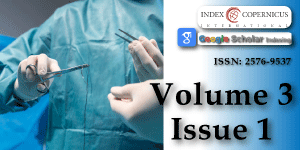Risk definition in Laparoscopic versus Open Cholecystectomy
Main Article Content
Abstract
Nothing without risk. As cholecystectomy is one of the most common procedures, any minor risk will be a mass volume. This study was to define the magnitude of that risk. In the study were 1486 patients between Feb. 2009 and April. 2018. Open in 292 (19.6%), 1194 (80.4%) laparoscopically, 1086 [91%] completed so and 108 (9%) converted. There were 18 (1.2%) with bile duct injury. 1 (0.3%) in the open group and 17 (1.4%) in the laparoscopic group. 9 diagnosed during surgery, 4 with jaundice, 2 early and 2 late, 5 with leak. Statistically the operative injury is insignificance in the 2 groups (P<0.3). The jaundice was significantly high in the laparoscopic group of patients (P<0.045). Also the bile leak (P<0.028). The same for morbidity (P<0.01. The revers was for mortality (P<0.04).
Conclusion: The incidence of CBD injury in the literature is less than the actual rate. Laparoscopic interventions have a higher rate of injury and the proximal ducts are at higher risk.
Article Details
Copyright (c) 2019 Abdelhamid MS, et al.

This work is licensed under a Creative Commons Attribution 4.0 International License.
Zha Y, Chen XR, Luo D, Jin Y. The prevention of major bile duct injures in laparoscopic cholecystectomy: the experience with 13,000 patients in a single center. Surgical Laparoscopy, Endoscopy and Percutaneous Techniques. 2010; 20: 378–383. Ref.: https://goo.gl/ovSwkY
Archer SB, Brown DW, Smith CD, Branum GD, Hunter JG. Hunter, Bile duct injury during laparoscopic cholecystectomy: results of a national survey. Annals of Surgery. 2011; 234: 549–559. Ref.: https://goo.gl/PP5H5U
Flum DR, Koepsell T, Heagerty P, Sinanan M, Dellinger EP. Common bile duct injury during laparoscopic cholecystectomy and the use of intraoperative cholangiography. Arch Surg. 2001; 136: 1287-92. Ref.: https://goo.gl/vqzZBZ
Gouma DJ, Go PM. Bile duct injury during laparoscopic and conventional cholecystectomy. J Am Coll Surg. 1994; 178: 229-233. Ref.: https://goo.gl/zqhusY
Calvete J, Sabater L, Camps B. Bile duct injury during laparoscopic cholecystectomy: Myth or reality of the learning curve? Surg Endosc. 2000; 14: 608-611.
Jarnagin WR, Blumgart LH. Operative repair of bile duct injuries involving the hepatic duct influence. Arch Surg. 1999; 134: 769-775. Ref.: https://goo.gl/N8jU3o
Branum G, Schmitt C, Baillie J, Suhocki P, Baker M, et al. Management of major biliary complications after laparoscopic cholecystectomy. Ann Surg. 1993; 217: 532-541. Ref.: https://goo.gl/xTeK86
West Cott CJ, Pappas TN. Benign biliary strictures. In Cameron JL (ed). Current surgical therapy.: St. Louis, Missouri, Mosby. 1998; 425-434.
Swinscow TDV, Campell MJ. Statistics at Square one. In TDV Swinscow (ed). Plymouth, Latimer trend & Company Ltd. 1996; 1-138. Ref.: https://goo.gl/9nGN2n
Tokumura H, Rikiyama T, Harada N, Kakyo M, Yamamoto K. Laparoscopic biliary surgery. Nippon Geka Gakkai Zasshi. 2002; 103: 737-734. Ref.: https://goo.gl/ZJsg4y
Sandha GS, Bourke MJ, Haber GB, Kortan PP. Endoscopic therapy for bile leak based on a new classification: results in 207 patients. Gastrointestinal Endoscopy. 2004; 60: 567–574. Ref.: https://goo.gl/Hx7XKU
Murr MM, Gigot JF, Nagorney DM, Harmsen WS, Ilstrup DM, et al. Long term results of biliary reconstruction after laparoscopic bile duct injuries. Arch Surg. 1999; 134: 604- 610. Ref.: https://goo.gl/dg1b16
Machado NO. Biliary Complications Post Laparoscopic Cholecystectomy: Mechanism. Preventive Measures, and Approach to Management: A Review. Diagnostic and Therapeutic Endoscopy. 2017: 967017. Ref.: https://goo.gl/ryhiQG
Buanes T, Wauge A, Mjaland O, Solheink K. Bile leak after cholecystectomy significance and treatment. Int surg. 1996; 81: 276-279. Ref.: https://goo.gl/gJfVbR
Pineres G, Yama Kawa T, Kasugai H, Fukuda N, Ishiyama J, et al. Common bile duct stones. J hepato biliary Pancreat Surg. 1998; 5: 97-103. Ref.: https://goo.gl/AZ9yVc
Giuliante F, Vellone M, Fianchini M and Nuzzo G. The surgical risk of laparoscopic cholecystectomy. Ann Ital Chris. 2016; 69: 723-729. Ref.: https://goo.gl/vQEBEq
Paczynski A, Koziarski T, Stanowski E, Krupa J. Extrahepatic bile duct injury during laparoscopic cholecystectomy. Med Sci Monit. 2002; 8: 438-440. Ref.: https://goo.gl/oemJB5
Mercado MA, Chan C, Orozco H, Cano-Gutiérrez G, Chaparro JM, et al. To stent or not to stent bilioenteric anastomosis after iatrogenic injury. Arch surg. 2002; 137: 60-63. Ref.: https://goo.gl/uQJ3QL
Mahatharadol V. Bile duct injuries during laparoscopic cholecystectomy: Anaudit of 1522 cases. Hepatogastroenterology. 2014; 51: 12-40. Ref.: https://goo.gl/cMfz6L
Heise M, Schmidt SC, Adler A, Hintze RE, Langrehr JM, et al. Management of bile duct injury following laparoscopic cholecystectomy. Zentralbl Chir. 2003; 128: 944-951. Ref.: https://goo.gl/YM5EEt
Ludwig K, Bernhardt J, Steffen H, Lorenz D. Contribution of I.O.C. to the incidence and outcome of common bile duct injury during LC. Surg Endosc. 2015; 16: 1098-1104. Ref.: https://goo.gl/SFkXnS





